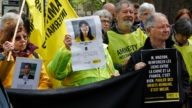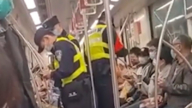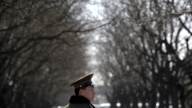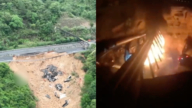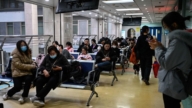【新唐人2014年06月27日訊】中共當局進一步加強對藏區喇嘛寺廟的監督和控制,在甘肅省夏河的拉卜楞寺地區增設24個派出所。中共當局向寺廟進駐警力和工作組的作法,使輿論擔心這種高壓管控方式,很可能引發藏人更大的反彈。
總部在印度達蘭薩拉的「藏人行政中央」,引述美國民間組織「國際聲援西藏運動」發佈的一份報告說,中共當局自2010年11月開始,在青海省全境133座大、中型藏傳佛教寺廟中設立派出所。
目前,在甘肅省藏區的24座寺廟中也同樣設立了警務機構,僅在甘肅夏河縣,一週之內就有5座寺廟設立了警務治安機構。
報告認為,這一舉動是中共當局政策的組成部分,意在直接監督地區內的所有喇嘛寺廟,同時加強中共在西藏城市和鄉村地區的出現。
「藏人行政中央」駐臺代表達瓦才仁指出,中共當局拿不出有效管理藏區的辦法,只是一味向寺廟進駐警力和工作組等,這種高壓管控方式很可能引發藏人更大的反彈。
印度藏人行政中央駐臺代表達瓦才仁:「到現在為止,中共對西藏的這樣一個高壓政策,在不斷的強化,在西藏這些壓制都是非常化的,從08年以後,一直都是不停的在加強當中,中共正在把西藏變成一個大的監獄,專門針對西藏民族的一種鐵幕,西藏中共政府正在打造這樣一種鐵幕。」
去年10月份,一名藏族中共高官出書,揭露中共當局在藏人地區的暴政,他說,西藏拉薩街頭武裝警察的行為「極其不人道」,他們像毒蛇一樣冷血的殺人,肆意毆打當地居民,掠奪民眾的財產,如果民眾反抗,就將他們殺死。
「國際聲援西藏運動」在一份聲明中指出,自2008年西藏抗議事件後,中共實施有目標的戰略措施,來加強對西藏的管控,目前,中共再以保障寺廟安全為名,進駐警務人員,有系統的加強對喇嘛寺廟的管控和所謂「愛國」主義教育。
藏文媒體寫道,中共當局正在試圖利用忠實於中共專政體制,取代藏人對達賴喇嘛的忠貞,由此,從根本上威脅西藏民族身份。
中共當局在一份文件中宣稱,在甘肅省夏河縣增設24個派出所,是西藏地區「近期對喇嘛寺廟政治化問題的關注」。夏河縣是藏人自焚最為嚴重的地區,自2009年至今,當地已有幾十名藏人自焚。
2012年初,中共當局在藏區強行開展「送國旗、送領袖像進村入戶進寺廟」活動,要求藏傳佛教寺廟中必須懸掛中共「四大領袖」頭像,引發藏民的怒潮,導致當年有86位藏人自焚抗議。
美國長期關注中國民族問題的民間組織「公民力量」創建人楊建利指出,中共當局一向認為,藏傳佛教的寺廟是所謂「分裂勢力」最根本的力量,所以必須對寺廟進行控制。
美國「公民力量」創建人楊建利:「實際上,這種措施帶來的反彈非常大,因為寺廟感覺到宗教自由被鉗制得越來越嚴重,甚至寺廟和寺廟之間的聯絡都被切斷,最近幾年我們知道,藏人已經超過130多人,在藏區使用自焚的方法進行抗議,而開始主要是僧人,這和對寺廟的控制有直接的關係。」
「藏人行政中央」去年發佈一份名為《為甚麼西藏在燃燒?》的白皮書指出,藏人自焚的主要原因是在過去的60多年裡,中共對西藏實施政治上的壓迫、毀滅文化、社會歧視、經濟上的剝削、環境破壞而導致的。
採訪編輯/李韻 後製/孫寧
High-handed Control: 24 New Police Stations Set Up in Tibet
To strengthen the supervision and control of Tibetan Buddhist
Temples, the Communist regime has added 24 more police
stations in Labrang monastery, one of the biggest in the area.
This high-handed control tactic of using police forces
in the temples is criticized for creating further resentment,
and may trigger greater Tibetan backlash.
US-based non-governmental organization
The International Campaign for Tibet, reports that
the Chinese regime began establishing police stations
in Qinghai Province"s 133 large and medium-sized
Tibetan Buddhist monasteries, as early as in November 2010.
Police offices have also been established in 24 monasteries
in the Tibetan Autonomous Prefecture, Gansu province.
Last week it was announced that five police offices would be
set up in monasteries in Xiahe, a Tibetan area of Gansu.
The new offices are part of a rollout of plans in Tibetan
Monasteries.
It is under the regime policies of placing almost every
monastery in Tibet under direct government rule
and intensifying Party presence in both rural
and urban Tibetan areas, said the report.
Representative of Religious Foundation of H.H. the Dalai Lama,
Taipei, Mr. Dawa Tsering says that instead of bringing effective
management to Tibet, the increasing presence of security forces
in temples will only create greater resentment among Tibetans.
Dawa Tsering: “Since 2008, the Chinese Communist Party
(CCP) has kept intensifying its high-handed policies in Tibet.
The CCP is making Tibet into one big prison,
creating an iron curtain made specifically for the Tibetans."
Last October, a senior Tibetan CCP official published a book
about the CCP’s tyranny in the Tibetan region.
He wrote that, on the streets of Lhasa,
the inhumane armed police kill people in cold blood,
beat people wantonly and loot local properties,
killing all who resist.
The International Campaign for Tibet reported,
“Following the protests that swept across Tibet in 2008,
the Chinese government has adopted a strategy of actively
stepping up Party presence as the answer to “instability."
“This has led to a more pervasive and systematic approach
to “patriotic education", the “management" and securitization
of monasteries and a dramatic increase in work teams
and Party cadres in rural as well as urban areas of Tibet."
The report continued, “The Chinese government
seeks to replace loyalty to the Dalai Lama among Tibetans
with allegiance to the Chinese Party-state, and in doing so,
to undermine Tibetan national identity at its roots."
Reportedly, the regime claimed the 24 additional police
stations in Xiahe County were set up in response
to political issues in Lama Temples.
Xiahe County has had the most severe cases of self-immolation.
Since 2009, dozens of local Tibetan self-immolation incidents
have taken place in Xiahe.
In early 2012, the regime forcibly launched a campaign to send
the CCP flag and pictures of party leaders to temples
and villages, demanding the pictures of the four leaders
be displayed in Tibetan Buddhist monasteries.
This angered many Tibetans, and resulted in protests
by 86 monks who self-immolated.
Initiatives for China founder Dr. Yang Jianli says that the CCP
sees the Tibetan Buddhist temples as the most fundamental
“separatist forces", and has thus pushed for intensified control.
Yang Jianli: “In fact, this measure has created huge resentment.
The temple’s religious freedom is increasingly suppressed,
and even contact between temples and monasteries is cut off.
We know that there are more than 130 Tibetans
who have protested by way of self-immolation.
At the beginning, most of them were monks.
This is directly related to the tightened control in the temples."
Last year, the Central Tibetan Administration
released a white paper entitled, “Why Tibet is burning."
This white paper examines the underlying causes
of the increasing number of self-immolations.
It says the reason lies the in more than 60 years of the CCP
ruling by using “political repression, cultural assimilation,
social discrimination, economic marginalisation
and environmental destruction."
Interview & Edit/LiYun Post-Production/SunNing



